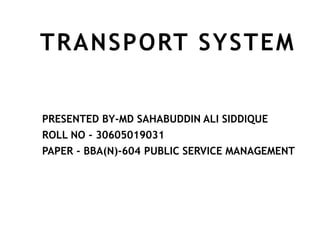
public-service-management-604.ppt
- 1. TRANSPORT SYSTEM PRESENTED BY-MD SAHABUDDIN ALI SIDDIQUE ROLL NO - 30605019031 PAPER - BBA(N)-604 PUBLIC SERVICE MANAGEMENT
- 2. INTRODUCTION □ TRANSPORT : Transport is a system in which passengers & goods are carried from one place to another. Well known and coordinated transportation plays an important role in the sustained economic growth of a country. When different regions of a country start specializng in certain selected products, the need for exchange automatically arises. Exchange of product or sending products to other places involves transportation.
- 3. IMPORTANT MEANS OFTRANSPORT □ Railways □ Road transport □ Water transport □ Ai r transport
- 4. RAILWAY TRANSPORT □ Development and expansion of railways lays revolutionized transport system world over. □ It is convenient mode of transport for long distance and suitable for carrying heavy and bulky goods. □ It has a crucial role in played and development of industrialization nations.
- 5. Ind ian rai Iways began thei r operati on in apri1- 1853 when the fi rst rai Iway steamed off from Bombay to Thane, a stretch of 34 km. Over the years the Indian railway system has grown to be the largest in Asia and 2nd largest in world. As far as of route lengths is concerned, Indian railway system is 4th largest in the world after US, Russia and China.
- 6. Importance (i) Indian railways carry most of long distances passenger traffic and 80% of total freight. (ii) Indian railways provide employment to a huge number of people in the country. (iii) Provide mail services. (iv) They carry big chunks of goods from place of production to ports. (v) Iron and steel industries based upon railways as they transport raw materials and finished products from one place to another.
- 7. — ■ ROAD TRANSPORT Roads are classified i nto followi ng4 categories 1. National highways - These roads li nks large cities and big industrial centers. 2. State Highways - These roads connects all important centres of industry, trade as well as commerce of the state and also national highways. 3. District Roads - These roads connect different parts of district , important industrial centres, important railway station. 4. Rural Roads- These are found in vllages both pucca or Metalled and kutch or Non-Metalled.
- 8. Advantages of road transport □ Door-to-door service □ flexibility □ Reliability □ Reach to remote places □ Speed
- 9. WATERTRANSPORT Water transport are cheapest method of shipping heavy , low value , non - perishable goods . Water transport can be divided into 2 categories. 1. Inland water transport- □ It includes natural modes such as navigable rivers and artificial modes. □ India has about 14,500 kms of navigable waterways. □ Development of IWT commenced from second five year plan - total outlay was around rs.34cr. Further rs.903cr was alloted for IWT in one tenth plan. Again, in 11th plan period three more waterways are proposed to be added to include coverage of additional 4,500km.
- 10. 2. Shipping - it is divided into 2 categories. (a)Coastal shi ppi ng (b) Overseas shi ppi ng (a)Coastal shipping - India has a longest coastline of 7,517 km, number of ports, 12 major and 200 non-major ports besides a vast hinterland It is the most energy efficient and cheapest mode of transport for carriage of bulky goods like iron and steel, coal ,iron ore ,timber ,etc over long distance.
- 11. AIRTRANSPORT □ Air transport is most modern ,quickest as well as latest edition to the mode of transport. Airports are managed by the Airports Authority of India (AAI). Efforts are on to provide with the latest scientific technology to ensure passengers safety and quick handling of passengers and freight traffic. In India, government first decided to air routes in 1920 between 1. Mumbai and kolkata 2. Kolkata and Rangoon Subsequently, during 10th plan period an expenditure of rs. 12,928 cr was provided to the ministry of civil Aviation out of which rs.7,792cr was spent. Further ,in 11th plan rs.43,560 cr was kept aside as total projected outlay.
- 12. THAN!TO